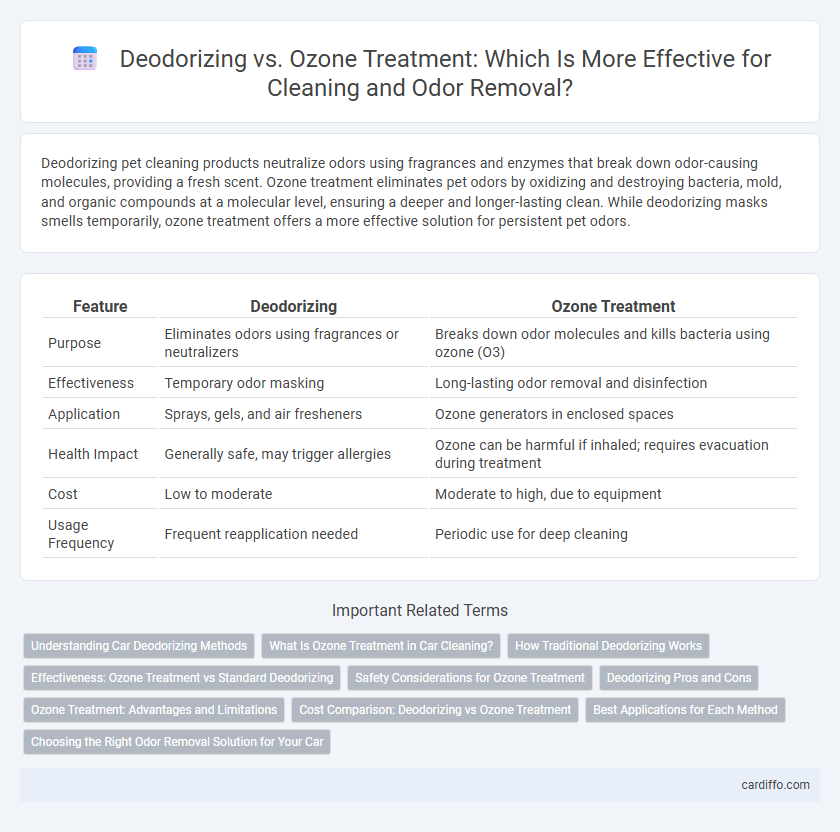Deodorizing pet cleaning products neutralize odors using fragrances and enzymes that break down odor-causing molecules, providing a fresh scent. Ozone treatment eliminates pet odors by oxidizing and destroying bacteria, mold, and organic compounds at a molecular level, ensuring a deeper and longer-lasting clean. While deodorizing masks smells temporarily, ozone treatment offers a more effective solution for persistent pet odors.
Table of Comparison
| Feature | Deodorizing | Ozone Treatment |
|---|---|---|
| Purpose | Eliminates odors using fragrances or neutralizers | Breaks down odor molecules and kills bacteria using ozone (O3) |
| Effectiveness | Temporary odor masking | Long-lasting odor removal and disinfection |
| Application | Sprays, gels, and air fresheners | Ozone generators in enclosed spaces |
| Health Impact | Generally safe, may trigger allergies | Ozone can be harmful if inhaled; requires evacuation during treatment |
| Cost | Low to moderate | Moderate to high, due to equipment |
| Usage Frequency | Frequent reapplication needed | Periodic use for deep cleaning |
Understanding Car Deodorizing Methods
Car deodorizing methods include traditional deodorizing sprays and ozone treatment, each targeting odors differently. Deodorizing sprays mask or neutralize surface odors using fragrances or chemical agents, while ozone treatment eliminates odors at a molecular level by breaking down odor-causing compounds in the air. Ozone generators require careful application due to potential health risks but offer a thorough solution for persistent and deep-seated car odors.
What Is Ozone Treatment in Car Cleaning?
Ozone treatment in car cleaning uses ozone gas (O3) to eliminate odors, bacteria, and mold inside the vehicle. This method oxidizes organic molecules responsible for unpleasant smells, providing a deep, chemical-free deodorizing effect. Ozone treatment is highly effective at sanitizing hard-to-reach areas like air vents and upholstery compared to traditional deodorizing sprays.
How Traditional Deodorizing Works
Traditional deodorizing works by masking or neutralizing odors through the use of fragrance agents and chemical compounds that interact with odor-causing molecules. Products like sprays, gels, and air fresheners release pleasant scents or absorb bad smells, but they do not eliminate the source of the odor. This method primarily targets the surface level, providing temporary odor control rather than deep sanitization or microbial eradication.
Effectiveness: Ozone Treatment vs Standard Deodorizing
Ozone treatment eliminates odors by breaking down pollutant molecules at a molecular level, proving far more effective than standard deodorizing sprays that merely mask smells. Scientific studies demonstrate ozone's ability to neutralize bacteria, mold, and volatile organic compounds (VOCs) that conventional deodorizers cannot fully eradicate. The superior penetration and oxidation power of ozone treatment make it a preferred choice for comprehensive odor removal in professional cleaning and environmental sanitation.
Safety Considerations for Ozone Treatment
Ozone treatment effectively deodorizes by breaking down odor-causing molecules but requires careful safety measures due to ozone's reactive and toxic nature at high concentrations. Proper ventilation and controlled exposure times are critical to prevent respiratory irritation and potential health risks. Users should avoid occupying treated spaces until ozone levels have fully dissipated to ensure safe indoor air quality.
Deodorizing Pros and Cons
Deodorizing effectively neutralizes unpleasant odors by targeting specific molecules and providing a fresher environment without disrupting indoor air quality. It is generally safe for regular use and does not require specialized equipment, making it an accessible solution for homes and offices. However, deodorizing masks odors rather than eliminating underlying causes like mold or bacteria, potentially necessitating repeated applications for lasting freshness.
Ozone Treatment: Advantages and Limitations
Ozone treatment offers powerful deodorizing capabilities by breaking down odor-causing molecules at the chemical level, making it highly effective against stubborn smells in various environments including homes, vehicles, and industrial spaces. This method provides rapid results without chemical residues, promoting a safer alternative to traditional deodorizing agents, yet it requires careful handling due to ozone's high reactivity and potential respiratory risks at elevated concentrations. While ozone treatment excels in sanitizing and neutralizing odors, its effectiveness can diminish if ozone is not evenly distributed or if the exposure time is insufficient.
Cost Comparison: Deodorizing vs Ozone Treatment
Deodorizing typically incurs lower upfront costs, ranging from $50 to $200 depending on the product and area size, while ozone treatment equipment and professional services can cost between $300 and $1,000 or more. Maintenance expenses for deodorizing are minimal, mainly involving replacement sprays or gels, whereas ozone generators require periodic servicing and filter replacements, adding to long-term expenses. Choosing between the two methods depends on budget constraints and the level of odor elimination needed, as ozone treatment offers more thorough sanitization but at a higher price point.
Best Applications for Each Method
Deodorizing techniques, including enzymatic sprays and activated charcoal, excel in removing specific household odors such as pet smells, cooking residues, and smoke from carpets, upholstery, and fabrics. Ozone treatment proves highly effective in industrial and larger-scale settings, neutralizing airborne contaminants and mold spores in HVAC systems, vehicles, and water damage restoration projects. Choosing deodorizing methods suits targeted odor elimination, while ozone treatment is ideal for comprehensive air purification and sanitization in confined spaces.
Choosing the Right Odor Removal Solution for Your Car
Deodorizing products effectively neutralize common car odors using scented agents and chemical neutralizers, providing quick, temporary relief. Ozone treatment eliminates odors at a molecular level by breaking down odor-causing bacteria and mold, offering a longer-lasting and more thorough solution. Selecting the right odor removal method depends on odor intensity, source, and desired permanence, with ozone treatment ideal for persistent or mold-related smells and deodorizing suitable for minor, surface-level odors.
Deodorizing vs Ozone Treatment Infographic

 cardiffo.com
cardiffo.com